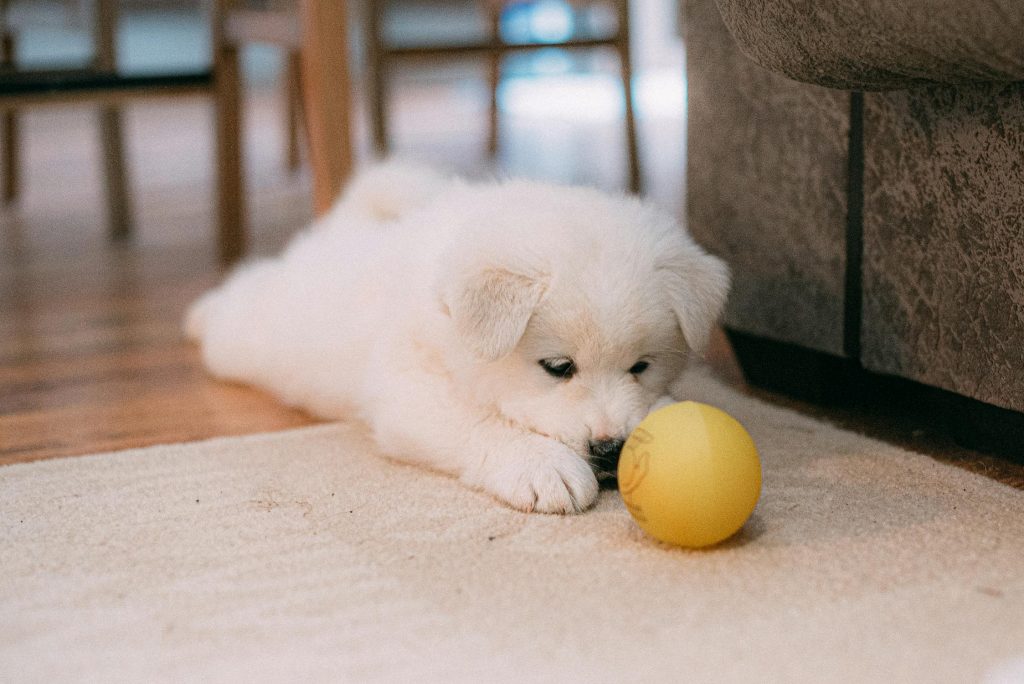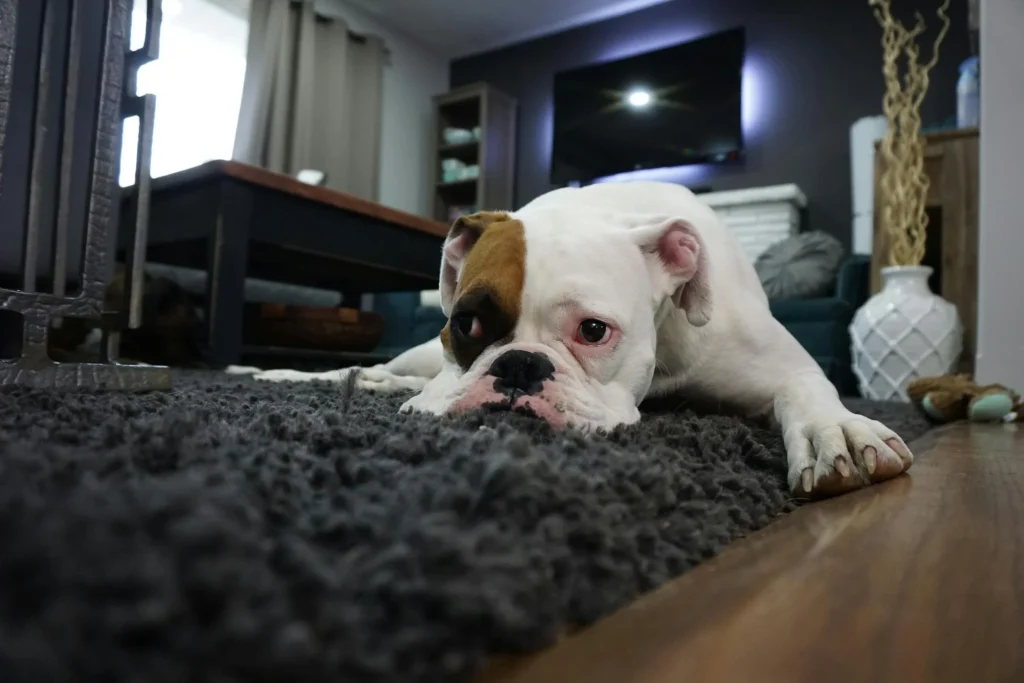Welcome, pet lovers! We know how much joy our furry friends bring into our lives, but along with the cuddles and playtime, comes the occasional mess. Accidents happen, and suddenly you’re faced with a pet stain on your beloved carpet. But don’t worry! This guide is your go-to resource for tackling those tough stains. Whether it’s a little accident from your puppy or an unexpected gift from your cat, we’ll show you how to clean up pet stains in no time.
So, let’s dive in and turn those dreaded stains into a thing of the past!

Table of Contents
The Challenge of Pet Stains
Living with pets brings immeasurable joy, but it also introduces the challenge of maintaining a clean and fresh home, especially when faced with pet stains on carpets. These incidents, while part of the pet-owning experience, can test even the most devoted pet lover’s patience and cleaning skills.
Types of Pet Stains
When dealing with pet stains, it’s crucial to know what type you’re facing as each requires a specific approach for effective removal.
1. Urine
The most common type, pet urine stains can soak deep into carpet fibers and padding, leading to persistent odors and discoloration. Dog pee smell can also be nasty. The uric acid in urine crystallizes over time, making the stain and urine odors difficult to remove completely without the right cleaning agents.
2. Feces
Feces stains are not only unpleasant to look at but also pose a risk of bacterial contamination. These stains can be somewhat easier to clean if addressed promptly, but like urine, the longer they sit, the harder they are to remove. They may also leave behind a lingering odor if not properly cleaned.
3. Vomit
Vomit stains are acidic, which can lead to rapid discoloration of carpets and rugs. The acidity can also break down carpet fibers if the stain is not promptly treated. Vomit can include a variety of substances, such as food or bile, each adding complexity to the cleaning process due to their differing compositions.

Composition and Persistence
Pet stains, whether from urine, feces, or vomit, are notorious for their stubborn nature. They’re not just visually unappealing but also difficult to remove completely. Their composition, especially urine, which contains uric acid, means they can penetrate deeply into carpets and underlay, causing lasting dog pee smells that are challenging to eliminate.
The Repeated Offense
One of the key challenges with pet stains is the tendency for pets to return to the scene of the crime. Animals are often drawn back to areas where their scent remains, leading them to soil the same spot repeatedly. This behavior reinforces the stain and makes it even more difficult to remove both the mark and the odor effectively.
Detecting and Addressing Stains
Identifying pet stains can sometimes be as challenging as removing them, particularly with lighter or more textured carpets where stains may not be immediately visible. The difficulty increases with older, set-in stains, which require more intensive cleaning efforts to remove.

Preparing for Battle
When it comes to battling pet stains on your carpet, being well-prepared is half the victory. Preparation involves a combination of having the right tools on hand, understanding the nature of the stain you’re dealing with, and adopting a proactive approach to tackle the issue efficiently.
Here’s how to gear up for the fight against pet stains:
What You’ll Need
Before diving into the cleaning process, ensure you have all the necessary tools and cleaning solutions ready. This toolkit might include:
Paper Towels or Clean Cloths: Essential for blotting up liquids and dabbing cleaning solutions onto stains.
Enzyme-Based Cleaners: These are specially formulated to break down the proteins in pet stains, effectively removing stains and odors.
White Vinegar and Baking Soda: Natural, pet-safe alternatives for DIY cleaning solutions.
Spray Bottle: For applying homemade or commercial cleaning solutions evenly.
Rubber Gloves: To protect your hands during the cleaning process.
Scrub Brush or Old Toothbrush: To gently work the cleaning solution into the carpet fibers.
Blacklight Flashlight: Handy for identifying older, less visible stains that might be causing odors.

Identifying the Stain
Understanding what type of stain you’re dealing with is crucial for choosing the most effective cleaning method. Different types of stains (urine, feces, vomit) require slightly different approaches for complete removal.
For instance, urine stains are best treated with enzyme-based cleaners designed to neutralize the odor and dissolve the stain. In contrast, vomit stains may require an acidic solution like vinegar to break down the stain.
The Right Cleaning Solution: How to Clean Pet Stains from Carpet
Selecting an appropriate cleaning solution is critical. While commercial pet stain removers are widely available and often very effective, it’s important to choose a product that is safe for your pets and suitable for your carpet type. A steam cleaner can be particularly helpful.
For those who prefer natural solutions, a mixture of vinegar and water, or sprinkle baking soda and hydrogen peroxide, can be quite effective for certain stains. However, always patch-test any cleaning solution in an inconspicuous area to ensure it won’t damage your carpet.
Strategic Approach: How To Remove Pet Stains From Carpet
Having a strategy before you start cleaning can save time and prevent the stain from worsening. This includes:
Acting Quickly: The sooner you tackle the stain, the better your chances of removing it completely.
Blotting, Not Rubbing: Always blot the stain gently to avoid spreading it further or pushing it deeper into the carpet fibers.
Working from the Outside In: This technique prevents the stain from spreading outward.
By preparing effectively, you’re not just ready to tackle the current stain but also better equipped to handle future accidents swiftly and efficiently. If you encounter something unspeakable, you may want to consider a professional carpet cleaner. They will be able to remove anything from dried dog urine, pet odors, and other stains from carpet.
This preparation ensures that when pet accidents happen, you’re ready to act fast, minimizing damage and keeping your carpets looking and smelling fresh.

To Wrap Up
And there you have it—your comprehensive guide to conquering pet stains on carpets. Armed with this knowledge, you’re now ready to face any mess that comes your way. Remember, the key to success is acting quickly and using the right methods and products. With a little patience and effort, your carpets can look and smell as good as new.
So, next time your pet decides to test your cleaning skills, you’ll know exactly what to do. Happy cleaning, and here’s to many more joyful moments with your furry friends, minus the worry about stains!

